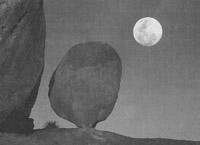Why does the moon seem bigger on the horizon?

The Moon is on the horizon or in the zenith, it has a different size for our eyes. Researchers have long known that this effect is only an optical illusion, but the reason for that illusion was not demonstrated. Two were the most likely explanations. To calculate the size and distance of the Moon, which according to one, is close to the horizon, we use as reference other objects that we see on the horizon and to which the Moon seems very distant.
When the Moon is in the zenith, however, we do not have the reference point and we have the feeling that the moon is closer. In both cases, the image of the Moon occupies the same surface in the retina, so the brain concludes that the Moon on the horizon is greater than that of the zenith. The other explanation said otherwise. It seems to us that the Moon in the empty sky is farther from what is on the horizon and as it is farther away, we see it smaller.
The experiences of father and son Kaufman with a mirror and the false Moons have concluded that the first theory is correct. But why does the farthest Moon, that is, the horizon, seem closer? Because the calculation of the supposed distance from the Moon is an unconscious operation of the brain that can counterpose our conscious experience that the horizon Moon seems closer.





